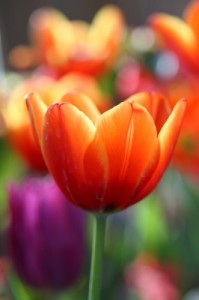Once the winter has given way to Spring and the first signs of new growth begin to emerge on your lawn, you can begin to anticipate the pleasing sights and enlivening scents of fresh grass and blooming gardens. The arrival of Spring should also be a reminder that there are certain activities that need to be done in preparation for the coming season. Although it may seem that your yard is brimming with life once more, there can be hidden patches of damage and disease lurking just under the surface. Inspection and maintenance of your lawn at this critical junction can help to undo any damage that may have occurred during the colder months.
The first step for the conscientious landscaper is to investigate the lawn for signs of insect infestation and disease. Sections of dead grass or leaves displaying patterns of insect feeding are good indicators that you might be facing a problem. The amount of damage that has been done will determine the corrective action that should be taken. If you find an accumulation of thatch, which is a vegetative material resting on the surface of the lawn, then it is a good idea to remove this material and aerate your lawn. After months of rather suffocating conditions, the soil and the potential new seed life need plenty of oxygen to spring into action once more. The precise time for dethatching your yard can vary slightly depending on the type of grass that is most prevalent. The best tool for the job is a heavy rake. If you are facing a serious dethatching project, then the job might go quicker using a sod cutter.
Aeration of your lawn is vital to a healthy lawn. The grass has been battered down and it is likely that, in addition to oxygen, rainwater is having difficulty penetrating the ground. Using a cylinder, rolling tool that is outfitted with spikes can assist in opening up channels into the dirt. It will also break up any clogged or compacted areas of soil that present an obstacle. Aeration and dethatching are best done at the same time. The soil will be looser from removing older vegetation, allowing for the aeration process to go more quickly.
As soon as the grass begins to reach towards the sun again, prepare to use the lawn mower. The lawn is not the only thing that will need attention after a long winter, however. Gardening equipment, movers, and other mechanical equipment should be thoroughly inspected after remaining dormant through the winter. Check the oil levels in all equipment requiring lubricants. Change filters in riding lawnmowers and ensure that axles are well greased. Any tool that uses blades to maintain the lawn should be carefully inspected for sharpness and rust. Attempting to care for the lawn using dull equipment results in simply tearing through the plant life rather than actually cutting it. Replacement parts and other scheduled maintenance on your lawn equipment should not be put on a back burner. Dispose of any gasoline that has been sitting in the equipment over the winter. Use fresh fuel.
Many gardeners do not think of using any weed killer until the weeds actually appear. At this point, however, you are in an uphill battle. In March or the beginning of April, make a preemptive strike. Pre-emergent weed killer can prevent weeds from forming before they actually appear. This precaution can save hours of back pain from pulling weeds out of your garden or lawn. These types of weed killers are safe for the lawn or garden as long as the recommended amounts are applied. A second spread of weed killer should be dispersed again in the middle of May.
Fertilizer is often misused by people hoping for fast results in their lawn or garden. A good strategy is to abstain from using fertilizer until the middle of May when the heat is on the rise. At that point, you should spread a reasonable amount of slow-release fertilizer so that its benefits are long-lasting. The most common recommendation is one pound of nitrogen for every 1,000 square feet being treated. All of the preparation up to this point should give you healthy and rich soil to sow your seeds for Spring. If you are just beginning to cultivate your lawn, then be sure to choose grass that works well with your regional climate. In warmer climates, buffalo grasses tend to thrive. Those residing in cooler areas should consider fescue grasses. A mixture of grasses for your lawn is always a wise strategy regardless of the climate in your area.
Contact Cubparts.com for all of your OEM Replacement Parts. They have a complete inventory of replacement parts and experts are available for questions. Cubparts.com has a user friendly online parts lookup tool, which enables users to locate parts by diagram, series or model number.

